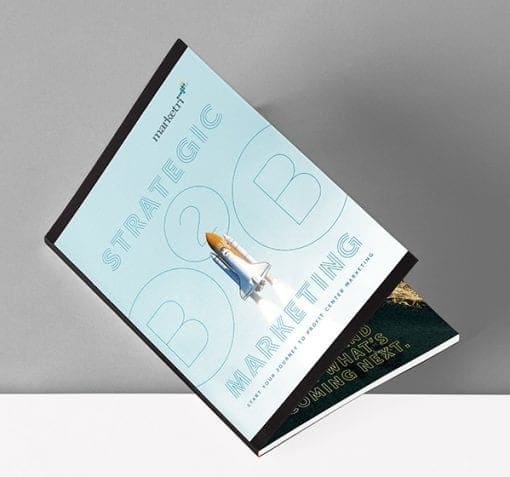B2B Marketing Strategies: How to Create Clearer Messaging
If you’re working on a small team with a limited budget and a growing to-do list, you might feel a hint of doubt creeping into your once-steeled resolve. After you’ve chosen the best B2B marketing strategies for your business, and you’re faced with the realities of execution, success might feel like a distant dream.
If that’s the case, take a moment, and a deep breath.
And remember that all good marketing only comes down to one thing. Resonance.
Resonance is at the very core of every successful marketing campaign. If you can understand and connect with your target audience, then you’re going to be just fine.
You can go about that in lot of ways—by your chosen media, your identification of specific pain points, or even in your color selection and visual branding. But right now, I’d like to focus on something a little more black and white: tightening up your core messaging.
I can think of four ways to create clearer messaging. So, let’s get writing.
1. Find a grandma, or a child. Get them to understand what your company does.
The Grandma Test is a common design exercise that helps you design with accessibility in mind. The premise is when pondering a design, a designer should ask: “Is this simple enough that a grandma can use it?” (Note: this isn’t a dig at grandmothers or their sophistication, as much as a thought exercise about someone removed from the issue at hand.)
The same should be said of messaging. If your company description is full of industry jargon, or you’ve just gotten comfortable with the same drawn-out explanation you’ve used for years, it’s likely time to work on accessibility.
The problem with jargon, or industry-laden descriptions, is that new audiences have to learn about your industry before they can understand what makes you better than the competition. It creates a learning curve that can be shortened drastically with tighter messaging.
I mean it when I say that you should sit with a grandma, or a child, and explain your business and your job. Embrace the simplicity of it. Try to find the combination of words that gets a listener from unaware to in-the-know as quickly as possible.
The core of the exercise is to focus on the audience’s understanding, rather than your own. By stripping out the excess, you’ll be left with the bare bones you need to describe your business.
And before you add back any of that fat to your description, ask yourself if it will resonate with the audience. If not, leave it out.
2. Go to happy hour. Listen to coworkers explain your company to the waitstaff.
This is one of my favorite ways to think about messaging. As someone who’s worked in marketing and in niche businesses, I find happy hour can be an informative place to be. If you’re seated in a group, there’s an inevitable moment when the server will ask, “What do you do?”
Three telling things can happen:
- Your coworkers turn to you. This typically means that they don’t know how to explain it, they don’t want to get in trouble by saying the wrong thing, or that the script changes too often. Better to ask the gatekeeper, and maybe check the company website for a dose of clarity.
- Your coworkers say something totally off-script. This means that your coworkers find friction in your messaging. (This is akin to them speaking on-script, but with an eye roll. Or a sigh.) What they say instead is very important to remember, because that’s your coworkers picking their shortest route to understanding. And why fight with their go-to messaging?
- Your coworkers stay on script. (Without sarcasm.) This is the best. This means you’ve found a sweet spot between scripted and spoken. Order another drink. Something special. You’ve earned it.
Just like with the grandma test, the goal is to find the shortest path to understanding. By removing what’s unnecessary, you can focus on the essentials. Then you can improve them.
3. Talk to your sales team. Learn what they say, and when.
A lot of businesses have an unhealthy divide between their sales and marketing teams. Generally speaking, this rift can happen because of a lack of understanding in the differences between marketing and business development (or sales). If I were to simplify the relationship, I’d put it this way: good marketing generates leads that sales can close easily.
The symbiosis between marketing and sales is imperative for closing new business. The more prospects can understand what they’re getting into, and the sooner they can do so, the more productive the sales process can be.
By listening to your sales team—by sitting in on prospect calls, reviewing sales decks, or listening to them at tradeshows—you can better mimic how they close deals. You can incorporate their language into your marketing materials. You can streamline their processes with materials. And they can focus on closing.
That level of care to understand sales can also help you build trust. (And if you develop higher-quality leads for them, that’ll certainly help too.) Over time, you can discuss why you want to use given words, or why certain concepts are important to your marketing efforts. The more fluidity between the two departments, the better.
4. Get help.
If you find you can’t figure out how to make your messaging resonate, then maybe it’s time to enlist some help. Bringing on a strategic marketing consultant, who can enlist copywriters or editors, can help you refine the language you’re currently using. They can also interview customers and employees from a neutral, third-party perspective, which can help if you find it difficult to get coworkers to open up.
For more strategic B2B marketing insights, download our Guide to Profit Center Marketing.






